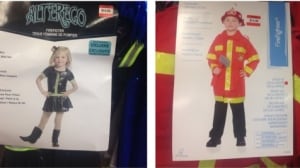Value Village pulls ‘sexy’ Halloween kids costumes
-metro (October 20,2014)
“We all know sex sells, but not on the backs of our children and our youth.” Value Village, a “store that promotes itself as a shopping destination for families,” was caught selling inappropriate Halloween costumes for children. Raina Delisle, the mother of a 4-year old, was looking for a firefighter costume for her daughter when she came across a shiny, tight, black costume that came with a fascinator for a helmet, and it was apparently what they called a suitable firefighter costume for little girls. She noticed that the firefighter costume for boys looked more bona fide than the one for girls, which did not look similar to the real thing at all. Shocked at the stark difference, she wrote about her experience in an online column that “sparked outrage on social media”.
It is wrong to market such sexualized clothes to young children as it can promote objectifying women and teach girls that “their bodies are more important than their brains”. Consumers, that is, families, must not let businesses make products that go against such important societal values. Stores are responsible for being ethical and keeping their products suitable for their target customer segment, but sometimes they might forget the big picture and start maximizing profits with the excuse that they are just giving consumers what they want. This happens because we, consumers, allow them to take advantage of the current issues that we have in society such as the inequality between men and women. We all need to be aware of how much influence we have on not only current trends and values, but on our youths as well, because they will be learning from what we do.





 afraid that they have not been very successful so far. A possible reason for their faulty vehicles would be that they are using cheap parts and materials in order to reduce their manufacturing costs. It’s understandable that companies would want to reduce all costs if possible, but there are certain things that customers expect from all automobile companies, and that is a safe vehicle for our families to ride in. In my opinion, Ford needs to work on their value proposition: will they continue reducing manufacturing costs or should they start focusing on delivering better quality products to their customers?
afraid that they have not been very successful so far. A possible reason for their faulty vehicles would be that they are using cheap parts and materials in order to reduce their manufacturing costs. It’s understandable that companies would want to reduce all costs if possible, but there are certain things that customers expect from all automobile companies, and that is a safe vehicle for our families to ride in. In my opinion, Ford needs to work on their value proposition: will they continue reducing manufacturing costs or should they start focusing on delivering better quality products to their customers?